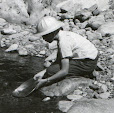The title of this post is taken from the title of a report written by Josephine County, Oregon Sheriff Gil Gilbertson who has been involved in a "clash" with the U.S. Forest Service regarding the latter agency's law enforcement efforts within his county. (Sheriff Gilbertson's actions as they relate to the mining community have been mentioned previously on this blog here, here, and here.)
According to Sarah Foster, writing in Oregon Sheriff Gil Gilbertson Continues Stand Against U.S. Forest Service at NWV News, Gilbertson's report is,
... a “must read” for anyone concerned about infringements against the 10th Amendment and federal encroachments in general – like road closures, Wild Lands and Monument designations, mining and other resource uses. In other words, this is for anyone and everybody with an interest – no matter how casual -- in accessing the public lands, either as a “resource user” (a rancher or miner) or simply a casual vacationer who enjoys weekend camping.
Sections of the report do deal with mining, in particular these paragraphs from page 10:
“Public land” that is disposed by claims under the act of 1872 becomes “Public Domain”. “The locators of all mining locations made on any mineral vein, lode, or ledge, situated on the public domain, their heirs and assigns, w(h)ere no adverse claim existed on the 10th day of May 1872 so long as they comply with the laws of the United States, and with State, territorial, and local regulations not in conflict with the laws of the United States governing their possessory title, shall have the exclusive right of possession and enjoyment of all the surface included within the lines of their locations.”
The mechanics of what happens to the “public land’ once found to be mineral in character is expressly evidenced in the Organic Act of 1897, that “any public lands embraced within the limits of any forest reservation which…” “…shall be found better adapted for mining or for agricultural purposes than for forest usage, may be restored to the public domain.” By private settlement under various land disposal laws of the United States, such as the Mining Law of 1872, “public land” is restored to the public domain.
The federal agencies have management authority only over “public land”, not privately settled public domain. The act of location restores the land to public domain and the mining law provides the locator of such segregation “shall have the exclusive right of possession and enjoyment of all the surface included within the lines of their locations”
Federal mining claims are “private property”
“but so long as he complies with the provisions of the mining laws his possessory right, for all practical purposes of ownership, is as good as though secured by patent.”
“All mining claims, whether quartz or placer, are real estate. The owner of the possessory right thereto has a legal estate therein with the meaning of ORS 105.005”
Setting the required boundaries of a mining claim literally sets a boundary describing land separate and distinct from agency authority placing the land under the exclusive authority and jurisdiction of the locator. This interest is also stated as case law and Forest Service Manual details.
And in this paragraph from page 11:
No section of the FLPMA (Federal Lands Policy and Management Act - 1976) and, therefore, no Forest Service authority may impair or amend locator’s rights under the act of 1872. Further that, “no provision of this section or any other section of this Act (FLPMA) shall in any way amend the Mining Law of 1872 or impair the rights of any locators or claims under that Act, including, but not limited to, rights of ingress and egress”
To get the full picture of Sheriff Gilbertson's research, one should read the entire 13 page report which is available as a .pdf here: Unraveling Federal Jurisdiction within a State.

No comments:
Post a Comment